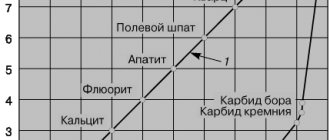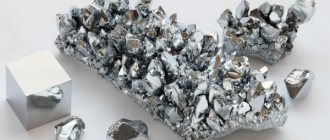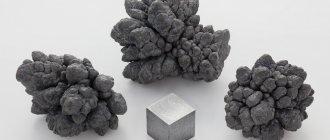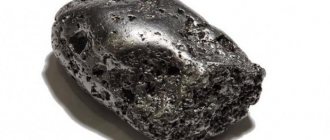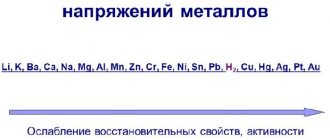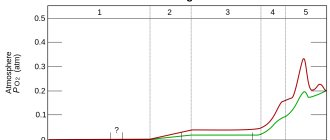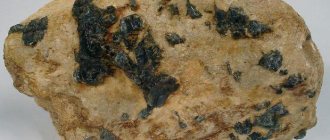| 2 | Helium |
| He 4,002602 ± 0,000002[1] | |
| 1s2 | |
Helium
(
He
, Latin helium) is a chemical element of the 18th group of the periodic system of chemical elements (according to the outdated classification - an element of the main subgroup of group VIII) of the first period of the system of chemical elements of D.I. Mendeleev, with atomic number 2. It heads the group of inert gases.
As a simple substance, it is an inert monatomic gas without color, taste or smell.
In terms of prevalence in the Universe, it ranks second after hydrogen and is the second lightest chemical substance, also after hydrogen. Its boiling point is the lowest of all known substances.
Helium is extracted from natural gas by a low-temperature separation process called fractional distillation.
Content
- 1 Discovery history 1.1 Origin of the name
- 2.1 In the Universe
- 5.1 Properties in the gas phase
- 9.1 In geology
- 10.1 Physiological effect
home > directory > chemical encyclopedia: Aluminum oxide
select the first letter in the article title:Aluminum oxide (alumina) Al2O3, colorless crystals; m.p. 2044°C; t. bale 3530 °C. The only crystalline modification of aluminum oxide stable up to 2044°C is A12O3 (corundum): rhombohedral lattice, a =
0.512 nm, = 55.25° (for hexagonal installation
a =
0.475 nm,
c
= 1.299 nm, space group D63d, z = 2);
density 3.99 g/cm3; Н°melt
111.4 kJ/mol;
temperature dependence equations: heat capacity С°р
= = 114.4 + 12.9*10-3
Т -
34.3*105
Т2
JDmol*K) (298
Т
1800 K), vapor pressure Igp (Pa) = -54800/ 7+1.68 (up to ~ 3500 K);
temperature coefficient of linear expansion (7.2-8.6)*10-6K-1 (300 T
1200 K);
thermal conductivity of the sample sintered at 730°C is 0.35 W/(mol*K); Mohs hardness 9; the refractive index for an ordinary ray is n0 1.765, for an extraordinary ray it is
n0 1.759. See table.
THERMODYNAMIC PROPERTIES OF ALUMINUM OXIDES
Modification -Al2O3 occurs in nature in the form of the mineral corundum, which often contains dissolved oxides of other metals, giving it different colors. Transparent colored crystals - precious stones (sapphires, rubies, etc.). Corundum can be obtained artificially as a result of thermal decomposition of the orthorhombic modification of AlOOH-diaspore or polymorphic transitions of metastable forms of Al2O3 (etc.), which are formed during the decomposition of crystalline modifications of Al(OH)3-gibbsite and bayerite and AlOOH-boehmite (see. Aluminum hydroxide).
These processes can be represented by the following diagram:
The A12O3 modification has a spinel-type tetragonal crystal lattice ( a =
0.562 nm, s = 0.780 nm); dense 3.3-3.4 g/cm3; contains structurally bound water in an amount of 1-2%. There is also amorphous aluminum oxide - aluminum gel, which is formed during the dehydration of gel-like Al(OH)3 and is a porous, sometimes transparent substance.
Aluminum oxide is insoluble in water, but soluble in molten cryolite. Amphoteric. Does not react with NH3-H2O. The chemical activity of synthetic aluminum oxide decreases greatly with increasing temperature of its production. Natural and artificial (formed above 1200°C) corundum in air under normal conditions is chemically inert and non-hygroscopic. Around 1000°C it interacts intensively with alkalis and alkali metal carbonates. giving aluminates. Reacts slowly with SiO2 and acidic slags to form aluminosilicates. When fusion interacts with KHSO4. Corundum formed from diaspore at 500-600 °C also interacts with solutions of acids and alkalis. Aluminum gel and Al2O3, obtained by firing Al hydroxides at ~550°C, are very hygroscopic and chemically active, reacting with solutions of acids and alkalis.
The raw materials for producing aluminum oxide are bauxite and nepheline. alunites, etc. When the ratio of Al2O3 : SiO2 in ores is > 6-7, they are processed according to the Bayer method (the main method), with Al2O3 : SiO2 by sintering with lime and soda.
According to the Bayer method, bauxite crushed in ball mills is leached in autoclaves with a circulating alkaline solution of Na aluminate (after separating part of the Al2O3 from it) at 225-250°C. In this case, aluminum goes into solution in the form of Na aluminate. For bauxites containing gibbsite, leaching can be carried out at 105°C and normal pressure in agitated apparatus. Aluminate solutions are diluted with water, the sludge is separated and subjected to decomposition in apparatus with a stirrer or airlift for 30-70 hours, and about 1/2
the resulting Al(OH)3. It is filtered and calcined in rotary kilns or in a fluidized bed at ~ 1200°C. The result is alumina containing 15-60% Al2O3. The mother liquor is evaporated and sent for leaching of a new batch of bauxite.
According to the second method, high-silica crushed ore (nepheline, etc.) is mixed with soda and limestone and sintered in rotary kilns at 1250-1300:C. The resulting mass is leached with an aqueous alkaline solution, the Na aluminate solution is separated from the sludge, then freed from SiO2, precipitating it in an autoclave at a pressure of about 0.6 MPa, and then with lime at atmospheric pressure, and the aluminate is decomposed into CO2 gas. The resulting Al(OH)3 is separated from the solution and calcined at a temperature of approx. 1200°C. When processing nepheline, in addition to alumina, Na2CO3, K2CO3 and cement are obtained. During the production of alumina from alunites, H2SO4 and K2SO4 are simultaneously obtained. Alunite ore is fired at 500-580°C in a reducing atmosphere and treated with NaOH solution according to the Bayer method. Single crystals are grown by zone melting using the Verneuil or Czochralski method.
Synthetic A12O3 is an intermediate product in the production of Al (main area of use), fire-resistant and abrasive material. It is also used in the production of ceramic cutters and electrical ceramics. Monocrystals - laser material, support stones of watch mechanisms, jewelry stones. Natural corundum is an abrasive (corundum wheels, emery) and fire-resistant material. Aluminum gel, Al2O3 and its mixture with - Al2O3 - adsorbents for drying gases (for example, H2, Ar, C2H2) and liquids (aromatic hydrocarbons, kerosene, etc.), in chromatography; catalysts (for example, dehydration of alcohols, isomerization of olefins, decomposition of H2S); carriers for catalysts (eg Co-MoO3, Pd, Pt).
World production of aluminum oxide is about 30 million tons/year (1980). Other aluminum oxides (see table) that exist in the gas phase are also known.
Lit.:
Chaly V.P., Metal hydroxides.
K.. 1972; Structure and properties of adsorbents and catalysts, trans. from English, M., 1973: Alumina production. 2nd ed., M., 1978; Zapolsky A.K., Sulfuric acid processing of high-silicon aluminum raw materials. K, 1981. © N. A. Kaluzhsky.
Yu.A. Volokhov. Additional information: “Aluminum oxide: chemical and physical properties.”
select the first letter in the article title:
History of discovery
On August 18, 1868, the French scientist Pierre Jansen, while during a total solar eclipse in the Indian city of Guntur, first examined the chromosphere of the Sun. Jansen managed to configure the spectroscope in such a way that the spectrum of the solar corona could be observed not only during an eclipse, but also on ordinary days. The very next day, spectroscopy of solar prominences, along with the hydrogen lines - blue, blue-green and red - revealed a very bright yellow line, initially taken by Jansen and other astronomers who observed it to be the sodium D line. Jansen immediately wrote about this to the French Academy of Sciences. It was subsequently found that the bright yellow line in the solar spectrum does not coincide with the sodium line and does not belong to any of the previously known chemical elements.
Two months later, on October 20, English astronomer Norman Lockyer, not knowing about the developments of his French colleague, also conducted research on the solar spectrum. Having discovered an unknown yellow line with a wavelength of 588 nm (more precisely - 587.56 nm), he designated it D3, since it was very close to the Fraunhofer lines D1 (589.59 nm) and D2 (588.99 nm) of sodium . Two years later, Lockyer, together with the English chemist Edward Frankland, with whom he worked, proposed giving the new element the name “helium” (from the ancient Greek ἥλιος - “sun”).
It is interesting that the letters from Jansen and Lockyer arrived at the French Academy of Sciences on the same day - October 24, 1868, but Lockyer's letter, written four days earlier, arrived several hours earlier. The next day, both letters were read out at a meeting of the Academy. In honor of the new method of studying prominences, the French Academy decided to mint a medal. On one side of the medal were engraved portraits of Jansen and Lockyer above crossed laurel branches, and on the other - an image of the mythological god of light Apollo, driving a chariot with four horses galloping at full speed.
In 1881, the Italian Luigi Palmieri published a report on his discovery of helium in the volcanic gases of fumaroles. He examined a light yellow oily substance that settled from gas jets at the edges of the crater of Vesuvius. Palmieri calcined this volcanic product in the flame of a Bunsen burner and observed the spectrum of gases released. Scientific circles greeted this message with disbelief, since Palmieri described his experience unclearly. Many years later, small amounts of helium and argon were actually found in fumarole gases.
Only 27 years after its initial discovery, helium was discovered on Earth - in 1895, Scottish chemist William Ramsay, examining a sample of the gas obtained from the decomposition of the mineral kleveite, discovered in its spectrum the same bright yellow line previously found in the solar spectrum. The sample was sent for additional research to the famous English spectroscopist William Crookes, who confirmed that the yellow line observed in the spectrum of the sample coincided with the D3 line of helium. On March 23, 1895, Ramsay sent a message about his discovery of helium on Earth to the Royal Society of London, as well as to the French Academy through the famous chemist Marcelin Berthelot.
Swedish chemists P. Kleve and N. Lenglet were able to isolate enough gas from kleveite to establish the atomic weight of the new element.
In 1896, Heinrich Kaiser, Siegbert Friedländer, and two years later Edward Bely finally proved the presence of helium in the atmosphere.
Even before Ramsay, helium was also isolated by the American chemist Francis Hillebrand, but he mistakenly believed that he had obtained nitrogen, and in a letter to Ramsay he recognized the priority of the discovery.
While examining various substances and minerals, Ramsay discovered that helium in them accompanies uranium and thorium. But it was only much later, in 1906, that Rutherford and Royds discovered that the alpha particles of radioactive elements were helium nuclei. These studies laid the foundation for the modern theory of atomic structure.
Graph of the dependence of the heat capacity of liquid helium on temperature.
Only in 1908, the Dutch physicist Heike Kamerlingh Onnes managed to obtain liquid helium. He used throttling (see Joule-Thomson effect) after the gas was pre-cooled in liquid hydrogen boiling under vacuum. Attempts to obtain solid helium remained unsuccessful for a long time, even at a temperature of 0.71 K, which was reached by Kamerlingh Onnes's student, the German physicist Willem Hendrik Keesom. Only in 1926, by applying pressure above 35 atm and cooling the compressed helium in liquid helium boiling under rarefaction, he managed to isolate the crystals.
In 1932, Keesom studied the nature of the change in the heat capacity of liquid helium with temperature. He found that around 2.19 K, a slow and gradual rise in heat capacity gives way to a sharp drop, and the heat capacity curve takes the shape of the Greek letter λ (lambda). Hence, the temperature at which a jump in heat capacity occurs is given the conventional name “λ-point.” A more accurate temperature value at this point, established later, is 2.172 K. At the λ-point, deep and abrupt changes in the fundamental properties of liquid helium occur - one phase of liquid helium is replaced at this point by another, and without the release of latent heat; a phase transition of the second order takes place. Above the temperature of the λ-point there is so-called helium-I
, and below it is
helium-II
.
In 1938, Soviet physicist Pyotr Leonidovich Kapitsa discovered the phenomenon of superfluidity of liquid helium-II
, which consists in a sharp decrease in the viscosity coefficient, as a result of which helium flows practically without friction. Here's what he wrote in one of his reports about the discovery of this phenomenon:
... the amount of heat that was actually transferred lies beyond the limits of physical capabilities that, according to any physical laws, a body cannot transfer more heat than its thermal energy multiplied by the speed of sound. Using the normal mechanism of thermal conduction, heat could not be transferred on the scale that was observed. It was necessary to look for another explanation. And instead of explaining heat transfer by conduction, that is, the transfer of energy from one atom to another, it could be explained more trivially by convection, the transfer of heat in matter itself. Isn't it possible that the heated helium moves up and the cold helium moves down, due to the difference in speeds, convection currents arise, and thus heat transfer occurs. But for this it was necessary to assume that helium flows without any resistance during its movement. We have already had a case where electricity moved without any resistance through a conductor. And I decided that helium also moves without any resistance, that it is not a superthermal conductive substance, but a superfluid. ... If the viscosity of water is 10⋅10−2 P, then it is a billion times more fluid than water ...
origin of name
From Greek ἥλιος - “Sun” (see Helios). It is curious that the name of the element used the ending “-ium” characteristic of metals (in Latin “-um” - “Helium”), since Lockyer assumed that the element he discovered was a metal. By analogy with other noble gases, it would be logical to give it the name “Helion”. In modern science, the name “helion” is assigned to the nucleus of a light isotope of helium - helium-3.
Prevalence
In the Universe
Helium is second in abundance in the Universe after hydrogen - about 23% by mass. However, helium is rare on Earth. Almost all the helium in the Universe was formed in the first few minutes after the Big Bang, during primordial nucleosynthesis. In the modern Universe, almost all new helium is formed as a result of thermonuclear fusion from hydrogen in the interior of stars (see proton-proton cycle, carbon-nitrogen cycle). On Earth, it is formed as a result of the alpha decay of heavy elements (the alpha particles emitted during alpha decay are helium-4 nuclei). Part of the helium that appears during alpha decay and seeps through the rocks of the earth's crust is captured by natural gas, the concentration of helium in which can reach 7% of the volume or higher.
Earth's crust
Within the eighteenth group, helium
It ranks second in content in the earth's crust (after argon).
The helium content in the atmosphere (formed as a result of the decay of thorium, uranium and their daughter radionuclides) is 5.27⋅10−4% by volume, 7.24⋅10−5% by mass. Helium reserves in the atmosphere, lithosphere and hydrosphere are estimated at 5⋅1014 m³. Helium-bearing natural gases contain, as a rule, up to 2% helium by volume. Extremely rare are accumulations of gases, the helium content of which reaches 8-16%.
The average helium content in terrestrial matter is 0.003 mg/kg or 0.003 g/t. The highest concentration of helium is observed in minerals containing uranium, thorium and samarium: kleveite, fergusonite, samarskite, gadolinite, monazite (monazite sands in India and Brazil), thorianite. The helium content in these minerals is 0.8-3.5 l/kg, and in thorianite it reaches 10.5 l/kg. This helium is radiogenic and contains only the isotope 4He, it is formed from alpha particles emitted during the alpha decay of uranium, thorium and their daughter radionuclides, as well as other natural alpha-active elements (samarium, gadolinium, etc.).
In 2021, Norwegian and British scientists discovered helium deposits in the Lake Victoria region of Tanzania. According to approximate estimates of experts, the volume of reserves is 1.5 billion cubic meters.
Significant reserves of helium are contained in the East Siberian gas fields in Russia. Helium reserves in the Kovykta field are estimated at 2.3 billion cubic meters, in the Chayandinskoye field - at 1.4 billion cubic meters.
Properties of helium (table): temperature, density, pressure, etc.:
Detailed information on the website ChemicalStudy.ru
| 100 | General information | |
| 101 | Name | Helium |
| 102 | Former name | |
| 103 | Latin name | Helium |
| 104 | English name | Helium |
| 105 | Symbol | Not |
| 106 | Atomic number (number in table) | 2 |
| 107 | Type | Non-metal |
| 108 | Group | Inert (noble) gas |
| 109 | Open | Joseph Norman Lockyer, UK, 1868, Pierre Jules César Jansen, France, 1868 |
| 110 | Opening year | 1868 |
| 111 | Appearance, etc. | An inert gas without color, odor or taste |
| 112 | Origin | Natural material |
| 113 | Modifications | |
| 114 | Allotropic modifications | |
| 115 | Temperature and other conditions for the transition of allotropic modifications into each other | |
| 116 | Bose-Einstein condensate | |
| 117 | 2D materials | |
| 118 | Content in the atmosphere and air (by mass) | 0,000073 % |
| 119 | Content in the earth's crust (by mass) | 5,5·10-10 % |
| 120 | Content in seas and oceans (by mass) | 7,2·10-10 % |
| 121 | Content in the Universe and space (by mass) | 23 % |
| 122 | Abundance in the Sun (by mass) | 23 % |
| 123 | Content in meteorites (by mass) | |
| 124 | Content in the human body (by weight) | |
| 200 | Properties of the atom | |
| 201 | Atomic mass (molar mass) | 4.002602(2) a. e.m. (g/mol) |
| 202 | Electronic configuration | 1s2 |
| 203 | Electronic shell | K2 L0 M0 N0 O0 P0 Q0 R0 |
| 204 | Atomic radius (calculated) | 31 pm |
| 205 | Empirical atomic radius | |
| 206 | Covalent radius | 28 pm |
| 207 | Ion radius (crystalline) | |
| 208 | Van der Waals radius | 140 pm |
| 209 | Electrons, Protons, Neutrons | 2 electrons, 2 protons, 2 neutrons |
| 210 | Family (block) | s-family element |
| 211 | Period in the periodic table | 1 |
| 212 | Group on the periodic table | 18th group (according to the old classification - the main subgroup of the 8th group) |
| 213 | Emission spectrum | |
| 300 | Chemical properties | |
| 301 | Oxidation states | 0 |
| 302 | Valence | 0 |
| 303 | Electronegativity | 4.5 (Pauling scale) |
| 304 | Ionization energy (first electron) | 2372.32 kJ/mol (24.58738880 (15) eV) |
| 305 | Electrode potential | 0 V |
| 306 | Electron affinity energy of an atom | 0 kJ/mol |
| 400 | Physical properties | |
| 401 | Density* | 1.7846 10-4 g/cm3 (at 20 °C and other standard conditions, the state of matter is gas), 1.785·10-4 g/cm3 (at 0 °C and other standard conditions, the state of matter is gas), 0.125 g/cm3 (at a boiling point of -268.928 °C and other standard conditions , the state of the substance is liquid), 0.147 g/cm3 (at -270 °C and other standard conditions , state of matter – liquid) |
| 402 | Melting temperature | -272.20 °C (0.95 K, -457.96 °F) (at 2.5 MPa pressure) |
| 403 | Boiling temperature | -268.928 °C (4.222 K, -452.070 °F) |
| 404 | Sublimation temperature | |
| 405 | Decomposition temperature | |
| 406 | Self-ignition temperature of a gas-air mixture | |
| 407 | Specific heat of fusion (enthalpy of fusion ΔHpl)* | 0.0138 kJ/mol |
| 408 | Specific heat of evaporation (enthalpy of boiling ΔHboiling)* | 0.0829 kJ/mol |
| 409 | Specific heat capacity at constant pressure | |
| 410 | Molar heat capacity* | 20.78 J/(K mol) |
| 411 | Molar volume | 31.81 cm³/mol |
| 412 | Thermal conductivity | 0.1513 W/(mK) (at standard conditions ), 0.152 W/(mK) (at 300 K) |
| 500 | Crystal cell | |
| 511 | Crystal grid #1 | |
| 512 | Lattice structure | Hexagonal close-packed |
| 513 | Lattice parameters | a = 3.570 Å, c = 5.84 Å |
| 514 | c/a ratio | 1,633 |
| 515 | Debye temperature | |
| 516 | Name of space symmetry group | Fm_3m |
| 517 | Symmetry space group number | 225 |
| 900 | additional information | |
| 901 | CAS number | 7440-59-7 |
Note:
401* The density of helium according to [1] is 1.786·10-4 g/cm3 (at 0 °C and normal conditions, the state of the substance is gas).
407* The specific heat of fusion (enthalpy of fusion ΔHmel) of helium according to [4] is 0.00723 kJ/mol.
408* The specific heat of evaporation (enthalpy of boiling ΔHboiling) of helium according to [4] is 0.084 kJ/mol.
410* The molar heat capacity of helium according to [3] is 20.79 cm³/mol.
Physical properties
Helium is a practically inert chemical element.
The simple substance helium is non-toxic, colorless, odorless and tasteless. Under normal conditions it is a monatomic gas. Its boiling point (T = 4.215 K for 4He) is the lowest of all substances; Solid helium was obtained only at pressures above 25 atmospheres - at atmospheric pressure it does not transform into the solid phase even at absolute zero. Extreme conditions are also necessary to create a few chemical compounds of helium, all of which are unstable under normal conditions.
Helium atom and molecule. Helium formula. Structure of the helium atom:
Helium (He, lat. helium) is a chemical element of group VIII of the short form (18th group of the long form) of the periodic system of chemical elements of the first period of the system of chemical elements of D. I. Mendeleev, with atomic number 2.
Helium is a non-metal. Helium heads the group of inert gases in D. I. Mendeleev’s periodic table of chemical elements .
As a simple substance, helium under normal conditions is an inert monatomic gas without color, taste or smell.
The helium molecule is monatomic.
Chemical formula of helium He.
The electronic configuration of the helium atom is 1s2. The ionization potential (first electron) of the helium atom is 2372.32 kJ/mol (24.58738880 (15) eV).
The structure of the helium atom. A helium atom consists of a positively charged nucleus (+2), around which two electrons move in the atomic shell (s-orbital). Since helium is located in the first period, there is only one shell. In turn, the nucleus of a helium atom consists of two protons and two neutrons. Helium belongs to the elements of the s-family.
The radius of the helium atom (calculated) is 31 pm.
The atomic mass helium atom is 4.002602(2) a. e.m. (g/mol).
Helium is a practically inert chemical element.
Helium, properties of the atom, chemical and physical properties
Chemical properties
Helium is the least chemically active element of group 18 (inert gases) and, in general, of the entire periodic table. Many helium compounds exist only in the gas phase in the form of so-called excimer molecules, in which the excited electronic states are stable and the ground state is unstable. Helium forms diatomic molecules He+ 2, HeF fluoride, HeCl chloride (excimer molecules are formed by the action of an electric discharge or ultraviolet radiation on a mixture of helium with fluorine or chlorine).
The binding energy of the molecular helium ion He+ 2 is 58 kcal/mol, the equilibrium internuclear distance is 1.09 Å.
The excimer chemical compound of helium LiHe is known.
Helium, properties of the atom, chemical and physical properties.
He 2 Helium
4.002602(2) 1s2
Helium is the second element of the periodic system of chemical elements of D.I. Mendeleev with atomic number 2. It is located in the 18th group (according to the old classification - the main subgroup of the eighth group), the first period of the periodic system.
Helium atom and molecule. Helium formula. Structure of the helium atom
Isotopes and modifications of helium. Helium-I and helium-II Helium-3
Properties of helium (table): temperature, density, pressure, etc.
Physical properties of helium
Chemical properties of helium. Helium interaction. Reactions with helium
Helium production
Application of helium
Table of chemical elements D.I. Mendeleev


